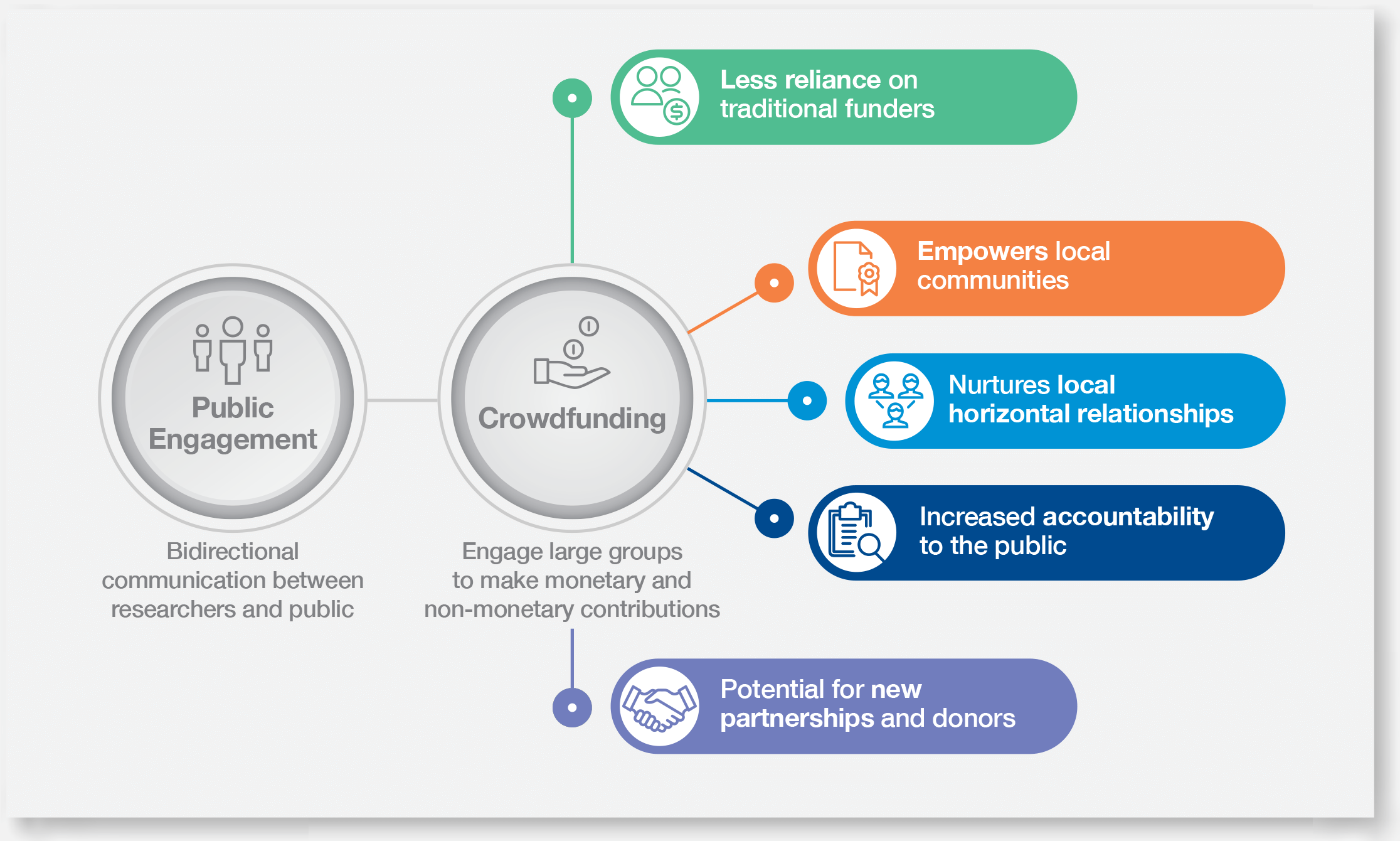Executive Summary
Public engagement is essential for high-impact scientific research. Public engagement in research is a bi-directional communication between the researcher and the public for mutual benefit. The public are people in general and especially the local community. Public engagement involves communication and advocacy with the public over time, demanding a strong understanding of the local setting. It adds scientific, practical and ethical value across the lifespan of a research study and is a prerequisite for crowdfunding for health research. We define crowdfunding for research as the process of engaging large groups of people who make monetary and non-monetary contributions to a research project. Crowdfunding requires a creator passionate about the research, networks of potential supporters, and an organizer.
The following consensus statement provides practical tools and suggestions for public engagement and crowdfunding, with a focus on LMICs:
General principles related to public engage-ment to lay the foundation for crowdfunding for research
- Public engagement is a dynamic process that requires sustained relationships with key stakeholders in the local community.
- Partnerships with people affected directly or indirectly by the topic and experts from the local community can build powerful networks, empower communities, develop messages, and establish a rationale for public support.
- Diverse communication materials that are easily understood by the local public and inclusive of key groups are important for public engagement.
- Co-creation of messages with the public provides a mechanism to iteratively engage people, refine potential crowdfunding campaign materials, increase acceptability, and foster transparency and accountability.
- Open access resources provide frameworks and tools to facilitate public engagement in research.
Crowdfunding for research
- Crowdfunding is a multi-stage process that includes creators (researchers creating the campaign), backers (people providing both monetary and non-monetary support) and organizers (groups linking creators and backers).
- Potential advantages of crowdfunding for research include the following: less reliance on traditional funders; nurturing local, horizontal connections and relationships; expanding public engagement strategies; and potential for raising money for research.
- Potential modifiable risks of crowdfunding identified in the qualitative evidence synthesis include lack of standardized peer review, inability to monitor research funding allocation post-campaign, and fewer protections against fraud and falsification.
- Some important considerations before launching a crowdfunding campaign include the following: finalizing the public engagement strategies and their dissemination plans; assigning promotion responsibilities; identifying and engaging an organizer; finalizing the budget for the campaign; preparing all stages of the campaign; and creating post-campaign plans.
- The characteristics that increase the likelihood of successful crowdfunding for research include the following: strong links to multiple networks related to the research focus; robust institutional champions and organizers; a clear rationale for public involvement; strong government support; approval from ethical review committee and related institutional approvals; and appealing storytelling embedded within the campaign.
Pre-campaign
- Create a detailed plan for public engagement across the entire life of the campaign. This includes plans to promote and design the campaign through online digital strategies and offline or in-person strategies. Consideration of translation into local languages is important.
- Listen to end users and people affected by the problem to describe the impact of the problem on the local community. Provide opportunities for community-led action on research findings.
- Identify professional, personal and other networks who may be interested in donating to the crowdfunding campaign and design events to discuss with potential backers.
- Organize user testing to refine the campaign plan, including pilot testing campaign materials and public engagement strategies among local community members. This can also inform when to launch the campaign.
During the campaign
- Speak at public events, use conventional media, and create digital messages to promote the campaign and draw attention to the cause by sharing with personal and professional networks.
- Consistently communicate clearly, concisely, and if possible, in the local language of the intended audience.
- Update the public on progress related to the campaign through text or video messages.
After the campaign
- Report back on research progress to the backers and fulfill obligations in the campaign strategy.
- Disseminate findings of the research study to the public, local government authorities, and other key stakeholders using open access methods.
- Foster new research relationships and continue public engagement, focusing on the local community and building horizontal relationships.
